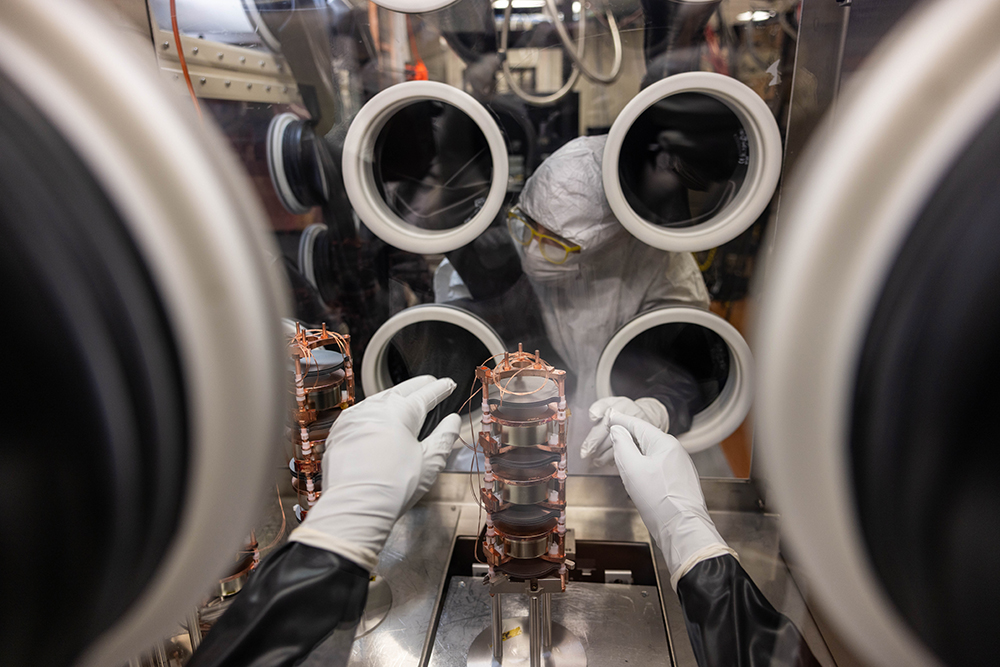MAJORANA DEMONSTRATOR’S legacy becomes LEGEND

The Majorana Demonstrator experiment at SURF proved the viability of new methods in the search for ultra-rare physics events. As the experiment decommissions, the lessons learned continue to drive future discovery.
By Mike Ray, SURF Media Relations Manager
Imagine setting a stopwatch at the Big Bang, some 14 billion years ago, and letting it tick every second until right now.
So far, you’d have counted about 4 x 1017 seconds. That’s a four in front of 17 zeros.
But if you are looking to observe a theoretical process like neutrinoless double-beta decay from an atom, you could be waiting more than 1026 years. It’s a span of time so vast that our imaginary stopwatch would have clocked a billion trillion universes stacked back-to-back.
So why are scientists so interested in the question of a mind-bogglingly rare event like neutrinoless double-beta decay? If observed, it would mean the neutrino is its own antiparticle. This observation would violate the standard model of physics—which is essentially the mathematics that frames the basic understanding of how our universe functions. This is the kind of shift in knowledge that could change the very foundation on which future technology is built.
Ralph Massarczyk is a staff research scientist at Los Alamos National Laboratory who worked on the Majorana Demonstrator at the Sanford Underground Research Facility (SURF). Massarczyk says neutrinos could be a key that transforms our understanding of physics and our universe.
“We know the neutrinos are a little bit different than all the other particles. They are acting, in a certain sense, even a little bit weird,” said Massarczyk. “Neutrinos don't behave as you expect. They disappear, they change flavor, so there's a lot of room for what could happen. And neutrinoless double-beta decay is one of them.”
But this decay process is so rare, prior to Majorana, some scientists were not convinced it could even be detected.
First, you’d need a super sensitive experiment, one capable of filtering out all the other noise from natural radiation that would get in the way of this very tiny and very rare signal.
This is one of the challenges the Majorana Demonstrator managed to overcome. The experiment began to take form at SURF in late 2010 with data taking occurring between 2015 and 2022. Today, the incredible success of the Majorana Demonstrator is continuing to unfold even as the project is being decommissioned and the next generation of experiments examining this same question are moving forward.
“The Majorana Demonstrator showed that an advanced design for the germanium detector works, and that the materials could be made at a level of purity that was previously unachieved. That's what Majorana prides itself on, the development of clean materials and clean material handling techniques, that work was all done here at SURF,” said Vincente Guiseppe a senior research scientist at Oak Ridge National Laboratory who is also the Majorana Collaboration Co-Spokesperson.
The task of providing components clean enough to work in this super sensitive detector, fell not on physicists, but chemists. Cabot-Ann Christofferson is a research scientist at South Dakota Mines who joined the Majorana Collaboration as a chemist when activities at SURF were beginning. She now leads the effort to “grow” radiopure copper underground at SURF for use in the Majorana Demonstrator and other experiments worldwide.
“We have an incredible setup here at SURF so there is no need to relocate this work. The clean room, wet lab, and the adjacent machine shop on the 4850 Level Davis Campus provides capability currently unequaled anywhere else in the world,” Christofferson said.
Christofferson adds the electroforming lab at SURF is also fortunate to have a strong team of skilled scientists, engineers, and technicians alongside a steady stream of science and engineering students from South Dakota Mines.
“The university has provided almost 30 students from across a range of disciplines over the past 15 years. We have been able to expose these students to world-class research and world-leading science happening here at SURF,” said Christofferson.
The Majorana Demonstrator was the culmination of decades of work involving more than 100 collaborators, including university faculty, students, and research scientists from 16 institutions across four countries. Guiseppe points out the Majorana Demonstrator is continuing to advance world-class science while providing training for the next generation of researchers.
“We do this to advance knowledge and because this is good science. But we really are proud as a collaboration of the training opportunities we've given students. We have a lot of success stories,” Guiseppe said.
Many of the students who started at SURF on Majorana are now involved in the next-generation detector, the Large Enriched Germanium Experiment for Neutrinoless Double-beta decay (LEGEND).
The first iteration, LEGEND-200 is now operating at Gran Sasso National Laboratory in Italy with plans for a full metric ton experiment, LEGEND-1000, in the coming years. These experiments take bigger steps in observing an ultra-rare event like neutrinoless double beta-decay by increasing the sample size and improving the odds of catching the process in action.
Even with bigger experiments, the same extreme sensitivity is required for LEGEND, so copper electroforming and other clean material work at SURF will continue to play a key role in these projects in the years to come.
“When I think about LEGEND-1000 as the next scale and a bigger, more collaborative project worldwide, you still need a lot of the techniques and capabilities developed here at SURF,” Guiseppe said. “We value what SURF is going to provide LEGEND in the next decade or so in maintaining this important capability right here at SURF, because this is the right environment.”
Part of the mission of the Sanford Underground Research Facility is to advance world-class science. The Majorana Demonstrator was among the first physics experiments at SURF; the incredible success of this experiment is a testament to both the scientific value SURF has brought to the world and to the multidisciplinary collaborations that will continue to drive discovery and innovation at America’s Underground Lab and beyond.